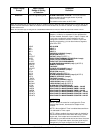
4/00 UDC 3300 Process Controller Product Manual 139
4.15 Alarms Set Up Group
Introduction
An alarm is an indication that an event that you have configured (for
example—Process Variable) has exceeded one or more alarm limits. There
are two alarms available. Each alarm has two setpoints. You can configure
each of these two setpoints to alarm on various controller parameters.
There are two alarm output selections, High and Low. You can configure
each setpoint to alarm either High or Low. These are called single alarms.
You can also configure the two setpoints to alarm on the same event and
to alarm both high and low. A single adjustable Hysteresis of 0 % to 100
% is configurable for the alarm setpoint.
See Table 2-8 in the Installation section for Alarm relay contact
information.
The prompts for the Alarm Outputs appear whether or not the alarm relays
are physically present. This allows the Alarm status to be shown on the
display and/or sent via communications to a host computer.
Alarms group
prompts
Table 4-14 lists all the function prompts in the Alarms Set Up group and
their definitions.
Table 4-14 Alarms Group Definitions
Lower Display
Prompt
Upper Display
Range of Setting
or Selection
Parameter
Definition
A1S1 VAL*
Value in engineering units ALARM 1 SETPOINT 1 VALUE—This is the value at
which you want the alarm type chosen in prompt
A1S1TYPE to actuate. The value depends on what the
setpoint has been configured to represent. NO setpoint is
required for Communications SHED. For SP Programming
the value is the segment number for which the event
applies.
For Maintenance Timers, the setpoint value is
HOURS.TENTHS OF HOURS. Example: setpoint value
4.2 means 4 hours 12 minutes. (Be aware that the value of
the Timer itself is displayed in HOURS.MINUTES.
Example: 4.2 means 4 hours 2 minutes.)
For Maintenance Counters for output relays 1 and 2, the
setpoint value is in thousands of counts (1 = 1000 counts).
This prompt does not appear for “Alarm on Manual” type
alarm. For example: A1S1TYPE = MANUAL.
A1S2 VAL*
Value in engineering units ALARM 1 SETPOINT 2 VALUE—This is the value at
which you want the alarm type chosen in prompt
A1S2TYPE to actuate.
The details are the same as A1S1 VAL.
A2S1 VAL*
Value in engineering units ALARM 2 SETPOINT 1 VALUE—This is the value at
which you want the alarm type chosen in prompt
A2S1TYPE to actuate.
The details are the same as A1S1 VAL.


















